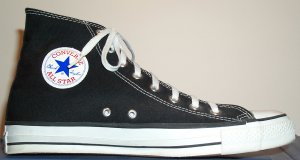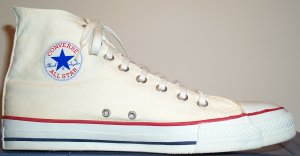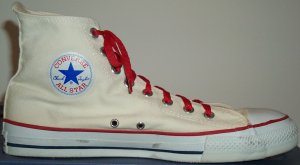

![]() When I was in college in the mid-1970's, I remember going to the University of Missouri Ellis Library and looking through their extensive collection of old magazines. Imagine my amazement when I found an ad for the Converse "Chuck Taylor" Athletic Shoe from 1935. These shoes, except for a slight difference in the name, looked just the Chucks we have now. They had the star logo, but with "Athletic Shoe" where "All Star" is now, in the exact typeface Converse still uses. The advertising copy praised the "gleaming black finish" (gleaming canvas?) and included endorsements from college basketball coaches. One stated that they stopped having ankle trouble when they switched the team to Chucks.
When I was in college in the mid-1970's, I remember going to the University of Missouri Ellis Library and looking through their extensive collection of old magazines. Imagine my amazement when I found an ad for the Converse "Chuck Taylor" Athletic Shoe from 1935. These shoes, except for a slight difference in the name, looked just the Chucks we have now. They had the star logo, but with "Athletic Shoe" where "All Star" is now, in the exact typeface Converse still uses. The advertising copy praised the "gleaming black finish" (gleaming canvas?) and included endorsements from college basketball coaches. One stated that they stopped having ankle trouble when they switched the team to Chucks.
During World War II, the "Chuck" went off to serve in the military. In fact, the Chuck was for many years defined in the military supply system, and is covered by Military Commercial Item Description MIL-S-43961. For those who can order from the US Government supply system: A size 12 white canvas low-top was National Stock Number 8430-00-257-3759 the last that I was able to look. (Other sizes were available.) Chuck Taylor, the man behind the shoe, served during World War II as a fitness consultant to the United States Armed Forces.

![]() At some point, Converse also added the white (unbleached cotton) model to their product line. The product line stayed with basic black and white until 1966.
At some point, Converse also added the white (unbleached cotton) model to their product line. The product line stayed with basic black and white until 1966.

![]() Before 1966, teams wanting some color in their Chucks either used colored shoelaces or dyed them in a washing machine.
Before 1966, teams wanting some color in their Chucks either used colored shoelaces or dyed them in a washing machine.

![]() Starting in 1966, Converse went on to add every color in the rainbow and myriad patterns to the familiar Chuck. Converse has also added non-canvas models to the product line.
Starting in 1966, Converse went on to add every color in the rainbow and myriad patterns to the familiar Chuck. Converse has also added non-canvas models to the product line.
Bill, a Baby Boom Boy friend and former co-worker of mine, was looking longingly at an earlier version of this very Web page and waxing rhapsodic about his old Chucks. Young Stevie (I called him "Young Stevie" because he commented about all his "old" co-workers), one of my former Generation X co-workers (who likes my Nike Air Up "Zebra Shoes") asked the two of us, "What are Chucks?"
If you grew up as a Baby Boom Boy, you had a pair of "Chucks." If you didn't, you likely envied your friends who had a pair of "Chucks." Your friends had them. If your friends were like mine, natural white. Usually with high tops but sometimes with low tops. I know that there were department store sneakers and PRO-Keds, in addition to "Chucks" when I grew up. Some Baby Boom Boys (and Girls) liked their deck sneakers as well. However, Chucks were the status sneaker for Baby Boom Boys up to about 1970. As I remember, they continued to be popular well into the 1970's. On the other hand, I remember reading US News and World Report in 1985. They had one of their Baby Boom Boy reporters, in a pair of high-top Chucks, that asked some Atlanta teenagers: "What's out of fashion?" They said, "Your sneakers!" His reply: "Hey, we Baby Boomers like our traditions!" They dropped out of high visibility for a while, then became a frequently seen footwear item again.
One Baby Boom reader of the USENET alt.clothing.sneakers newsgroup remembers a little ditty praising the "Chuck:"
"Don't get the kind that slip and slide!
Get the kind with the STAR on the side!"
Another Baby Boomer remembered his well-worn, high-top Chucks like this:
"The sneakers that fall over!"
A number of years back, I wore a pair of low-top Chucks at work. Young Stevie (having been indoctrinated into the mysteries of Chucks) noted and said, "Are those the weird sneakers with the big star on the side?" I had to disappoint him; if you've been reading up to this point, you know the low-tops don't have any star on the side! I had another surprise when I got back from Christmas vacation in 1995. Young Stevie has an even younger brother who played keyboards in a rock band. Like many rock musicians, his brother wears his black high-top Chucks faithfully!
In early 1998, I was out sneaker browsing at Academy Sports and Outdoors when I heard this incredible noise. When I looked in the next aisle, it was a customer vigorously jumping up and down, "testing out" a pair of natural white high-top Chucks. He had this big grin, and said "I haven't had a pair of these since I was a kid!" (I didn't note if he bought them.)
In December 2001, I had a Mom who told me: "Check out the shoe dress-code at St. Benedict's Prep High School, Newark, New Jersey for gym. Only Chuck Taylors allowed, no other kind of sneaker. I'm not kidding." She wasn't kidding, here's a direct quote from their dress code... and the policy is still in force as of Winter 2017: "Students shall only wear canvas Chuck Taylor sneakers for all school functions (exceptions may be granted to athletes during their practices and competitions)." She also commented they were hard to find... reports at that time were that the remaining US-made Chucks were sucked out of the warehouses by fanatics that thought they'd go away completely.
I've also had people write me and tell me that they've found Chucks in the family for four generations:
![]() Back to Charlie's "Chuck" Page
Back to Charlie's "Chuck" Page
![]() Back to the top of Charlie's Sneaker Pages!
Back to the top of Charlie's Sneaker Pages!
Last Updated: 19 August 2017
Click here to send E-mail to Charlie.
Charlie's Sneaker Pages copyright 1995-2024 by Charles L. Perrin.
READERS PLEASE NOTE: Names of athletic shoe manufacturers, shoe styles, and technologies may be trademarked by the manufacturers. Charlie's Sneaker Pages uses these names solely to describe the shoes with the same familiar nomenclature used by the manufacturer and recognized by the reader.